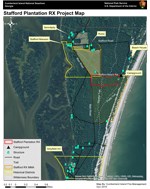Last updated: July 26, 2019
Article
Cumberland Island National Seashore Completes Prescribed Burn in Stafford Field

NPS Photo
On February 13, 2019, an interagency wildland fire crew conducted a prescribed burn in the Stafford Field and Plantation area of Cumberland Island National Seashore. The reintroduction of fire to this fire-adapted environment was carried out in an effort to protect structures and cultural resources, reduce encroaching woody species, and stimulate the new growth of grasses and forbs essential to the ecosystem.

NPS/R SINKOVITZ
Fire Management on Cumberland Island
For centuries, fire has shaped the Seashore's environment. Whether occurring naturally through a lightning strike, or introduced by humans to alter the landscape, fire plays an essential role in rejuvenating and maintaining a healthy ecosystem in the island's pine forests, oak hammocks, wetlands, and fields.
For most of the 20th Century, fires were suppressed on Cumberland, impacting the island's ecology, causing a build up of fuels, and influencing the populations of fire dependent species. In 2015, the park completed an updated fire management plan, which includes more active strategies like employing prescribed fire and managing wildfires for multiple objectives including resource benefit. The new management plan will better protect island visitors, residents, structures, facilities, and natural and cultural resource values, while addressing the need to restore fire to its natural role in the ecology of Cumberland Island.
The 2019 Stafford Prescribed Fire Operation
Primary ignition on the 114-acre Stafford Field unit began in the morning. The 59-acre Stafford Plantation unit was ignited in the early afternoon. The primary burn operations were completed by 5:00 P.M. and crew members stayed on to monitor the burned areas and watch for "hot spots" over the next two days.
Stafford Plantation Historic District
This area was once the location of the island's most productive and largest plantation operations. Applying prescribed fire helps to maintain the historic appearance, restores the ecosystem, and in time will reestablish a healthy natural fire regime.
Stafford Field is home to the island’s largest gopher tortoise population. The new green vegetation that sprouts following the fire will provide forage, while the clearing of duff has encouraged the population to expand their range. The number of recorded tortoise den sites in the neighboring Stafford Plantation tripled following previous applications of fire to that section of pine forest.

NPS Map
Increasing Preparedness
The Stafford area is located along the southern boundary of the nearly 10,000-acre designated wilderness area. Reducing fuels in the field and plantation tracts there accomplishes the objectives of protecting several historic and residential structures while also providing an anchor point to manage naturally occurring fires in the wilderness.

NPS Photo
Interagency Cooperation
The prescribed fire was an interagency effort accomplished with the support of partners from: Okefenokee National Wildlife Refuge, Savannah Coastal Refuges Complex, Osceola National Forest, Georgia Forestry Commission, NPS Mississippi River Zone Fire Management, and Timucuan Ecological & Historic Preserve.
Interagency cooperation supports successful fire management programs through the sharing of equipment and skilled personnel.
Providing for firefighter and public safety through proper preparation, planning and implementation for the duration of the project was the most important objective of the operation.
To find out more about Cumberland Island National Seashore's fire management program visit the park's Wildland Fire page.
